

|
195 |
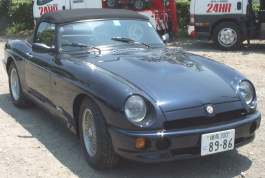 Oxford Blue 1764 in the yard shortly after passing through an auction and destined for export to an enthusiast in the UK. Less use of cars in Japan With superb and inexpensive cars, beautiful countryside and perfectly maintained major roads you might think it would make Japan a motorist's paradise. Unfortunately as land is scarce in the inhabitable areas of Japan this leads to large crowded cities and dormitory areas some considerable distance from major cities. So the reality tends to be congested urban areas and costly toll roads which take the fun out of long distance motoring and commuting by car. Holiday schedules are tight with short vacations and traffic jams of longer than 100km on toll highways are common during major holidays like the Golden Week, Obon and the New Year. Even potable toilets for use in the car are a necessary accessory when faced with such congestion! The efficient rail and subway transport systems are |
||||
| always preferred for daily commuting and the Shinkansen (bullet train) takes care of more serious, long distance travel needs. Cars are generally well cared for in Japan The condition of cars in Japan tends to be very good as they tend to be used less in Japan than in other countries and suffer less abuse in the hands of Japanese owners. Washing and waxing cars is done with a quasi religious fervour and even in modest income districts one can hardly find any neglected vehicles. Most cars, even highly tuned performance cars or sports utility vehicles, are never used to their full potential and spend their entire life in extended local neighbourhood and urban use together with much time proudly displayed on domestic courtyards. That good quality (condition and lower than average mileages) is further enhanced because cars manufactured in Japan and intended for the domestic market are always designed to higher specifications than export versions. In the case of the RV8, there was a higher specification for the models supplied to the Japanese market which included air-conditioning. That feature is particularly popular with Australian RV8 enthusiasts because of their hot summers. Brand new is good, but used is not In Japan there is a serious stigma attached to using or acquiring anything "used". This originates from ancient beliefs and it still affects all commodities including home appliances, automobiles and even houses! Purchasing a new home in Japan, for example, will inevitably result in its value shrinking by about 30% in the first five years and it will be considered equivalent to zero in 15 to 20 years. A similar attitude to cars exists. Even with the current economic slowdown and the newly acquired Japanese taste for bargains, the |
large majority of vehicles is still acquired as a new vehicle from a dealer. This is done by trading in a current vehicle, usually at Shaken renewal time - this is a serious MOT type test required after three, five, seven an nine years from new. Private car sales are non existent in Japan because they are technically impossible. To pass from one owner to the next, the vehicle must pass through the hands of an authorised dealer or auction. 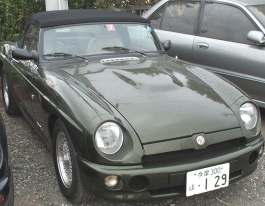 Woodcote Green 1009 in the yard after passing though an auction in Japan. Constraints on performance cars Strictly enforced speed limits of 40km/hr in urban areas and 100km/hr on toll roads mean performance cars like the RV8 are very rarely used at even modestly brisk speeds. The consequence is low mileage, immaculate vehicles which have been mainly been shown around by their proud owners. Car theft is virtually unknown in Japan and alarm systems are rare on Japanese cars. On the other hand, features such as power steering, electric windows and mirrors, climate control, and car stereo systems |
||||
|
Annual road
tax ranges from Yen40,000 (£240) for ordinary cars up
to Yen70,000 (£420) for luxury vehicles. |
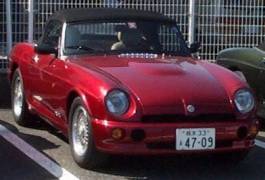 Nightfire Red 1218 in the yard after passing through an auction in Japan. Parking - the typical monthly fee would amount to Yen10,000 to Yen50,000 (£60 to £300) depending on the urban area. A parking space within a few hundred metres of an owner's house is a mandatory requirement if you wish to purchase a car. The police will come round to verify the size and location of that parking space! Insurance premium, other than the basic cost of the Shaken, amounts to at least Yen10,000 (£60) a month or £720 a year. General maintenance and repairs are never undertaken by the owner himself but by a dealer at a high price. Services, labour, rents and advertising costs are very costly in Japan. The major factor behind the rapidly falling car values and the tendency to early replacement is the Shaken. Besides providing a huge income for the government, it ensures every motor vehicle on Japanese roads is safe and sound. As the |
||||
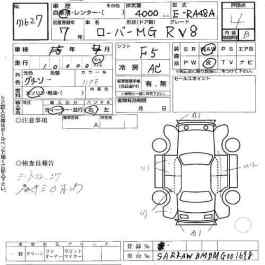 Woodcote Green 1698 - the auction condition sheet. 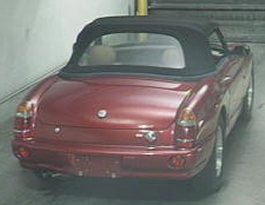 Nightfire
Red 2186 passing through an auction in Japan Nightfire
Red 2186 passing through an auction in Japan |
Shaken price is the same at each renewal, the aggregate cost will eventually amount to more than the value of the car itself. This explains why only an "eccentric person" would consider keeping a car longer than seven or nine years, regardless of its condition. The large majority of these artificially depreciated vehicles is sold at various auctions in Japan and exported to the rest of the World at a rate currently over 30,000 units a month. 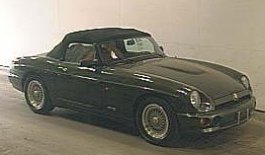 Woodcote Green 1698 passing through an auction - a typical photo received from Colin Shea. For regular reports of RV8s appearing at auctions in Japan, see our webpage with news from the RV8 Auctions in Japan. |